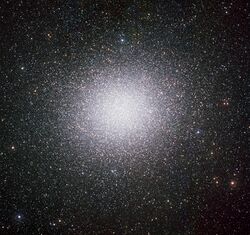Astronomy:List of largest known star clusters
From HandWiki
Short description: List of largest known star clusters
Below is a list of the largest known star clusters, ordered by diameter in light years, above the size of 50 light years in diameter. This list includes globular clusters, open clusters, super star clusters, and other types.
List
References
- ↑ Terzan 7 @ seds, archived from the original on 2002-10-24, https://web.archive.org/web/20021024065203/http://www.seds.org/~spider/spider/MWGC/ter07.html
- ↑ From trigonometry: radius = distance × sin( diameter_angle / 2 ) = 153 ly.
- ↑ "Angular Size calculator". http://1728.org/angsize.htm.
- ↑ Brosche, P.; Odenkirchen, M.; Geffert, M. (March 1999). "Instantaneous and average tidal radii of globular clusters". New Astronomy 4 (2): 133–139. doi:10.1016/S1384-1076(99)00014-7. Bibcode: 1999NewA....4..133B.
- ↑ Santos, J. F. C. Jr. et al. (October 2005), "Structure and stellar content analysis of the open cluster M 11 with 2MASS photometry", Astronomy and Astrophysics 442 (1): 201–209, doi:10.1051/0004-6361:20053378, Bibcode: 2005A&A...442..201S.
- ↑ distance × sin( diameter_angle / 2 ) = 87.3 ly. radius
- ↑ distance × sin(diameter_angle / 2), using distance of 5 kpc and angle 36.3′, = 86 ± 6 ly radius
- ↑ "Omega Centauri: The Largest Globular Cluster". http://www.universeforfacts.com/2013/11/omega-centauri-largest-globular-cluster.html.
- ↑ distance × sin(diameter_angle / 2) = 84 ly radius
- ↑ distance × sin( diameter_angle / 2 ) = 88 ly radius
- ↑ distance × sin( diameter_angle / 2 ) = 76 ly. radius
- ↑ From trigonometry: radius = distance × sin( diameter_angle / 2 ) = 67 ly.
- ↑ distance × sin( diameter_angle / 2 ) = 60 ly. radius
- ↑ distance × sin( diameter_angle / 2 ) = 53 ly. radius
- ↑ 15.0 15.1 From trigonometry: radius = distance × sin( diameter_angle / 2 ) = 50 ly
- ↑ Monaco, L.; Pancino, E.; Ferraro, F. R.; Bellazzini, M. (2004). "Wide-field photometry of the Galactic globular cluster M22". Monthly Notices of the Royal Astronomical Society 349 (4): 1278–1290. doi:10.1111/j.1365-2966.2004.07599.x. Bibcode: 2004MNRAS.349.1278M.
- ↑ distance × sin( diameter_angle / 2 ) = 49 ly. radius
- ↑ From trigonometry: radius = distance × sin( diameter_angle / 2 ) = 17,600 × sin(19′/2) = 48.6 ly.
- ↑ Nayak, P. K. et al. (September 2018). "Star clusters in the Magellanic Clouds. II. Age-dating, classification, and spatio-temporal distribution of the SMC clusters". Astronomy & Astrophysics 616: 24. doi:10.1051/0004-6361/201732227. A187. Bibcode: 2018A&A...616A.187N.
- ↑ From trigonometry: distance × sin( diameter_angle / 2 ) = 28,700 × 0.00157 = 45 ly. radius
- ↑ Boyles, J.; Lorimer, D. R.; Turk, P. J.; Mnatsakanov, R.; Lynch, R. S.; Ransom, S. M.; Freire, P. C.; Belczynski, K. (2011-11-20). "Young Radio Pulsars in Galactic Globular Clusters". The Astrophysical Journal 742 (1): 51. doi:10.1088/0004-637X/742/1/51. ISSN 0004-637X. Bibcode: 2011ApJ...742...51B. https://iopscience.iop.org/article/10.1088/0004-637X/742/1/51.
- ↑ From trigonometry: radius = distance × sin( diameter_angle / 2 ) = 32,900 × sin(8.8′/2) = 42.1 ly.
- ↑ distance × sin( diameter_angle / 2 ) = 41.6 ly. radius
- ↑ distance × sin( diameter_angle / 2 ) = 40 ly. radius
- ↑ From trigonometry: distance × sin( diameter_angle / 2 ) = 39.5 ly. radius
- ↑ Piskunov, A. E.; Schilbach, E.; Kharchenko, N. V.; Röser, S.; Scholz, R.-D. (June 2007). "Towards absolute scales for the radii and masses of open clusters". Astronomy & Astrophysics 468 (1): 151–161. doi:10.1051/0004-6361:20077073. ISSN 0004-6361. Bibcode: 2007A&A...468..151P. http://www.aanda.org/10.1051/0004-6361:20077073.
- ↑ Plotner, Tammy (February 22, 2016). "Messier 4 (M4) – The NGC 6121 Globular Cluster". https://www.universetoday.com/31147/messier-4/.
- ↑ distance × sin( diameter_angle / 2 ) = 37.2 ly radius
- ↑ distance × sin( diameter_angle / 2 ) = 34 ly. radius
- ↑ "Open Star Cluster NGC 290". April 18, 2006. https://sci.esa.int/web/hubble/-/39110-open-star-cluster-ngc-290.
- ↑ From trigonometry: radius = distance × sin( diameter_angle / 2 ) = 30 ly
- ↑ Joshi, Y. C. et al. (October 2016), "Study of open clusters within 1.8 kpc and understanding the Galactic structure", Astronomy & Astrophysics 593: 13, doi:10.1051/0004-6361/201628944, A116, Bibcode: 2016A&A...593A.116J.
- ↑ MacKey, A. D; Ferguson, A. M. N; Irwin, M. J; Martin, N. F; Huxor, A. P; Tanvir, N. R; Chapman, S. C; Ibata, R. A et al. (2010). "Deep Gemini/GMOS imaging of an extremely isolated globular cluster in the Local Group". Monthly Notices of the Royal Astronomical Society 401 (1): 533–546. doi:10.1111/j.1365-2966.2009.15678.x. Bibcode: 2010MNRAS.401..533M.
- ↑ Ma, J.; de Grijs, R.; Chen, D.; van den Bergh, S.; Fan, Z.; Wu, Z.; Wu, H.; Zhou, X. et al. (April 2007). "Structural parameters of Mayall II = G1 in M31". Monthly Notices of the Royal Astronomical Society 376 (4): 1621–1629. doi:10.1111/j.1365-2966.2007.11573.x. Bibcode: 2007MNRAS.376.1621M.
- ↑ Danilov, Vladimir M.; Seleznev, Anton F. (October 2020). "On the Motion of Stars in the Pleiades according to Gaia DR2 Data". Astrophysical Bulletin 75 (4): 407–424. doi:10.1134/S1990341320040045. ISSN 1990-3413. Bibcode: 2020AstBu..75..407D.
- ↑ Davies, B.; Figer, D. F.; Kudritzki, R. P.; MacKenty, J.; Najarro, F.; Herrero, A. (2007). "A Massive Cluster of Red Supergiants at the Base of the Scutum-Crux Arm". The Astrophysical Journal 671 (1): 781–801. doi:10.1086/522224. Bibcode: 2007ApJ...671..781D.
- ↑ Lodieu, N.; Pérez-Garrido, A.; Smart, R. L.; Silvotti, R. (2019-08-01). "A 5D view of the α Per, Pleiades, and Praesepe clusters". Astronomy and Astrophysics 628: A66. doi:10.1051/0004-6361/201935533. ISSN 0004-6361. Bibcode: 2019A&A...628A..66L. https://ui.adsabs.harvard.edu/abs/2019A&A...628A..66L.
- ↑ "Jewel Box Cluster". January 31, 2015. https://www.constellation-guide.com/jewel-box-cluster/.
- ↑ Perryman, M. A. C.; Brown, A. G. A.; Lebreton, Y.; Gomez, A.; Turon, C.; de Strobel, G. Cayrel; Mermilliod, J. C.; Robichon, N. et al. (1998), "The Hyades: distance, structure, dynamics, and age", Astron.astrophys. 331: 81, Bibcode: 1998A&A...331...81P
- ↑ "The Beehive Cluster". July 19, 2021. https://www.skyatnightmagazine.com/astrophotography/stars/star-clusters/beehive-cluster.
- ↑ Davies, B.; Figer, D. F.; Law, C. J.; Kudritzki, R. P.; Najarro, F.; Herrero, A.; MacKenty, J. W. (2008). "The Cool Supergiant Population of the Massive Young Star Cluster RSGC1". The Astrophysical Journal 676 (2): 1016–1028. doi:10.1086/527350. ISSN 0004-637X. Bibcode: 2008ApJ...676.1016D.
- ↑ Portegies Zwart, Simon F.; McMillan, Stephen L.W.; Gieles, Mark (2010). "Young Massive Star Clusters". Annual Review of Astronomy and Astrophysics 48: 431–493. doi:10.1146/annurev-astro-081309-130834. Bibcode: 2010ARA&A..48..431P.
 |


